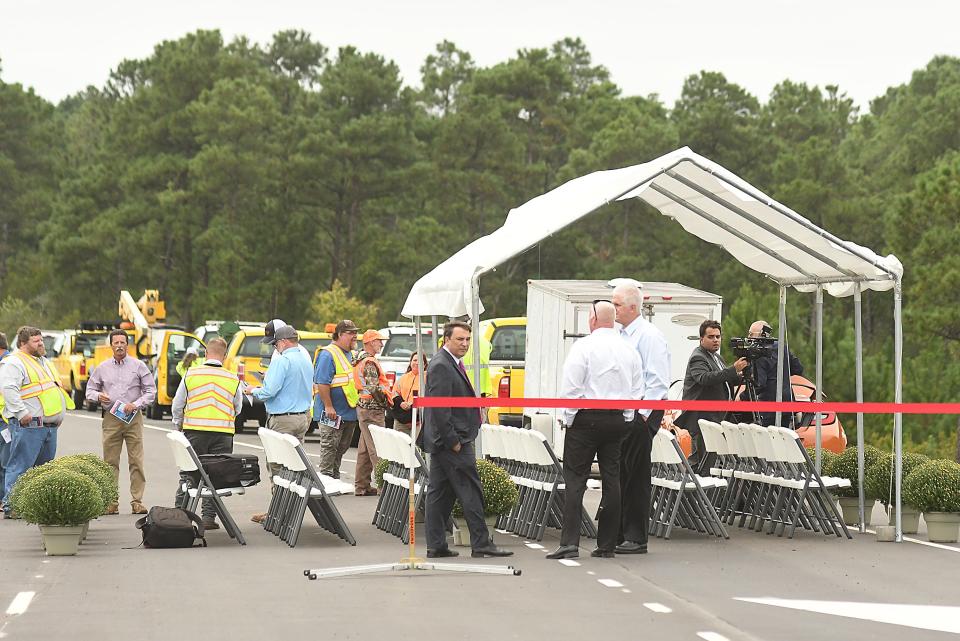With 'incalculable' impacts, 5 roadway projects that drastically changed Wilmington
Wilmington is experiencing ongoing growth and development, leading to expansions in transportation infrastructure and improvements in roadways.
Several major roadway projects are in progress among Brunswick, New Hanover and Pender counties, such as the current construction of the U.S. 17 Hampstead Bypass. And a rehabilitation project on the Cape Fear Memorial Bridge, which has resulted in temporary lane closures, has reignited discussion of a replacement span across the Cape Fear River.
More: New year, new developments: 13 projects to watch in New Hanover County in 2024
More: Here are 7 major projects to watch in Brunswick County for 2024
As Wilmington has rapidly evolved over the last 50 years, numerous transportation projects played a pivotal role in the region's development. Here are some of the most significant ones that have shaped the city's expansion and access.
Isabel Stellings Holmes Bridge (1980)
This bridge is proving more vital than ever thanks to eastbound lane closures on the Cape Fear Memorial Bridge.
A connection between Brunswick and New Hanover counties, this four-lane draw bridge opened in 1980, crossing the Northeast Cape Fear River from downtown Wilmington.
The Isabel Stellings Holmes Bridge replaced a prior bascule bridge (a movable bridge with a counterweight.). Before the building of the Cape Fear Memorial Bridge in 1969, this structure "carried the main east-west routes in and out of the city," according to an information webpage dedicated to the bridge.
As a connection to N. Third Street, "the main north-south thoroughfare in the downtown area," the improved bascule bridge helps direct tens of thousands of cars in and out of downtown Wilmington daily.
The bridge, originally named the Northeast Cape Fear River Bridge, was renamed in 1988 for Holmes, a former N.C. Department of Transportation secretary who died in 1978.
Interstate 40 Wilmington Extension (1990)
Perhaps the most influential transportation project completed in Wilmington to date is the Interstate 40 (I-40) Wilmington extension.
After a more than three-decade long effort, the extension of I-40 between Raleigh and Wilmington opened on June 29, 1990. The 122-mile stretch of interstate highway between the two cities cost a total of $417 million.
Wilmington resident and founder of Intracoastal Realty Jim Wallace said, "there's probably nothing that has happened in the history of this area that is more important than the opening of I-40," when reflecting on the construction of the roadway in 2015.
The extension provided improved access to Wilmington beaches, fostered enhanced business development, and residential expansion.
Tourist spending increased in New Hanover County by more than 52 percent in the ten years following the opening of the interstate, according to previous I-40 coverage. More than one-third of these tourists were other North Carolinians driving in from other regions statewide.
Gene Merritt, who organized North Carolina I-40 Inc., previously referred to the economic impact of I-40 as "incalculable."
More: 'Citizen warrior': Gene Merritt paved the way for today's downtown Wilmington
Interstate 140 Wilmington Bypass (2017)
When thinking of roadway enhancements that helped ease traffic congestion, the Interstate 140 (I-140) Wilmington Bypass comes to mind.
The final section of the I-140 Bypass opened to traffic on Dec. 19, 2017 after years of construction.
This 7.5-mile-long stretch of roadway, linking New Hanover and Brunswick counties, allows drivers to bypass congestion on U.S. 17 and U.S. 74-76 corridors, avoiding direct travel through Wilmington.
The final link of the I-140 Bypass cost $204 million to construct. The four-lane divided highway, with 19 bridges and two interchanges, helped to foster growth in northern Brunswick County.
Wilmington drivers shared how the bypass decreased their commute times following its opening, with one Leland resident describing the impact of the bypass as "fantastic" in 2018.
Love Grove Memorial Bridge (2018)

This $5 million bridge was "one of largest of the 38 projects approved by voters in the 2014 Transportation Bond," according to the city of Wilmington.
The bridge provides additional access to the Love Grove neighborhood, crossing Burnt Mill Creek to One Tree Hill Way. The previous entrance into the neighborhood faced blockages from train traffic.
The city said this project addressed "a long-held concern in the area."
After just over a year of construction, the Love Grove Memorial Bridge opened on April 29, 2018.
Military Cutoff Road Extension (2023)
The most recent of the larger roadway projects is the Military Cutoff Road extension, which opened to the public with a ribbon-cutting ceremony on Sept. 28, 2023.
The $106 million project allows for more than 60,000 drivers to pass through Military Cutoff Road from Market Street to I-140 daily.
The four-mile extension took five consecutive years of construction to complete. While the bypass was built to ease traffic congestion and provide an alternative route, economic growth also played a role in project planning.

"Mobility and connectivity are essential to move people and goods around our state … transportation is about economic benefits," Joey Hopkins, NCDOT Secretary, said following the completion of the extension.
The extension enhances port accessibility by directing eastbound traffic towards Hampstead and westbound traffic towards I-40 and Brunswick County, as highlighted by Hopkins.
This article originally appeared on Wilmington StarNews: The major Wilmington, NC road projects from the past 50 years

